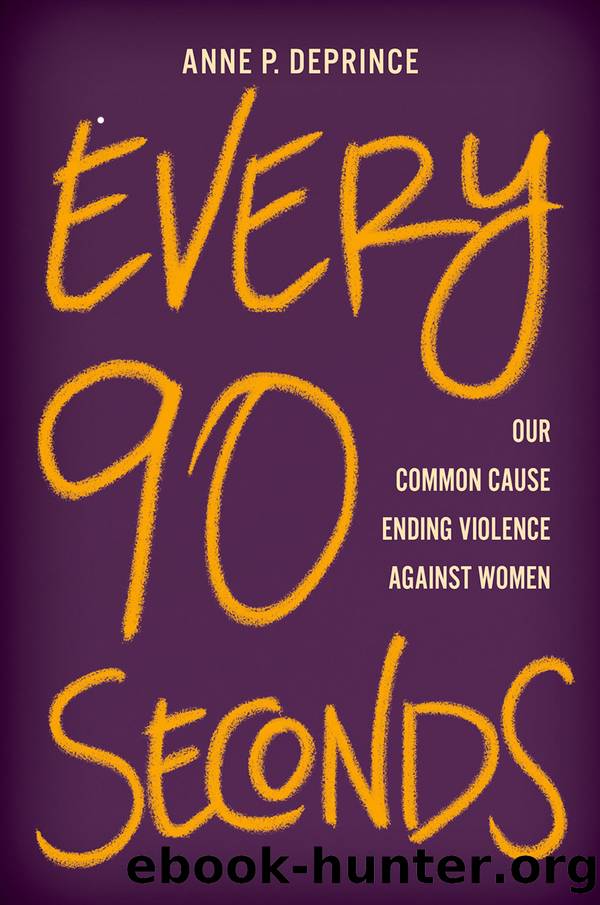Every 90 Seconds by Anne P. DePrince

Author:Anne P. DePrince
Language: eng
Format: epub
Publisher: Oxford University Press
Published: 2022-04-15T00:00:00+00:00
Economic Drivers of Violence Against Women
As the 2020 coronavirus pandemic unfolded, states across the US and countries around the world issued stay-at-home orders. The actions taken to slow one public health crisisâthe spread of COVID-19âseemed to accelerate another oneâthe victimization of women and children. Women around the world were now shut in their homes with their abusers, and the media was paying attention. Something in the public discourse seemed palpably different. Instead of asking outright (or implying) âwhy does she stay?â people were realizing âshe canât leave.â Long before a novel coronavirus circled the globe, however, many women couldnât safely escape abusive relationships, often due to economic barriers.
Early in the COVID-19 crisis, piecing together what was happening with domestic violence rates was difficult. Some communities seemed to have increases in calls to law enforcement while others did not. National hotlines were inundated with calls, but local hotlines varied in whether or not calls were on the rise. Since then, researchers have estimated that domestic violence incidents went up about 8% with lockdown orders.62 But in those early weeks, when the situation was unclear, reporters were asking experts across the country whether the stress of the virus and lockdowns was causing domestic violence.
Stress does indeed play a role in some crimes. From examples, criminologists have demonstrated that strains are particularly important to peopleâs propensity to commit property crimes.63 But, what about the reportersâ hypothesis that dramatic changes in the macroeconomic landscape seed intimate violence in particular?
Economists and criminologists alike have turned to past economic downturns and unemployment data to try to understand this complex landscape. One team of researchers from the University of London made use of national data on crime as well as regional unemployment rates to tackle questions about gender, economic stress, and domestic violence.64 The researchers started with a couple of premises, including that men predisposed to violence toward their intimate partners could either hide those tendencies or not. They imagined that, under some economic conditions, men would have good reasons to hide abusive tendencies in order to be more like non-abusive men. For example, a man who doesnât have much earning potential married to a woman who makes a good living might try to hide his violent tendencies from her lest she leave him. Yet another man with more earning potential than his wife might not have reasons to hide his violence. Sheâd be likely to end up stuck in the relationship whether or not he revealed his abusive tendencies, so he wouldnât have much incentive to keep those tendencies in check. Based on this logic, the researchers predicted that these probabilities and pressures would show up in national trends, such that menâs and womenâs unemployment would be linked with different rates of domestic violence across the United Kingdom.
To test their predictions, the research team looked at data from the British Crime Survey. The crime survey included nationally representative samples of people living in England and Wales who were age sixteen and older with unemployment data by geographic police force areas.
Download
This site does not store any files on its server. We only index and link to content provided by other sites. Please contact the content providers to delete copyright contents if any and email us, we'll remove relevant links or contents immediately.
Adding Value to Policy Analysis and Advice by Claudia Scott; Karen Baehler(455)
Sociological Perspectives of Health and Illness by Constantinos N. Phellas(444)
Race and American Political Development by unknow(441)
American Government and Politics Today by Steffen W. Schmidt Mack C. Shelley Barbara A. Bardes(424)
Human and Global Security : An Exploration of Terms by Peter Stoett(424)
Control Of Oil - Hardback by Kayal(407)
Entrepreneurship Education and Training: The Issue of Effectiveness by Colette Henry Frances Hill Claire Leitch(364)
The Catholic Church and European State Formation, AD 1000-1500 by Jørgen Møller(355)
Materializing the Middle Passage by Jane Webster;(349)
The World According to China by Elizabeth C. Economy(343)
Left Is Not Woke by Susan Neiman(328)
Turkey's Relations with the West and the Turkic Republics: The Rise and Fall of the Turkish Model by Idris Bal(313)
Theories of Counseling and Psychotherapy: A Case Approach by Nancy L. Murdock(313)
Cross-Cultural Child Development for Social Workers by Lena Robinson(306)
Japan's Ainu Minority in Tokyo by Mark K. Watson(297)
Advances in Child Development and Behavior, Volume 37 by Patricia J. Bauer(295)
Laboratory Life by Bruno Latour(294)
Beyond Service: State Workers, Public Policy, and the Prospects for Democratic Administration by Greg McElligott(284)
The Oxford Handbook of Museum Archaeology by Stevenson Alice;(275)
